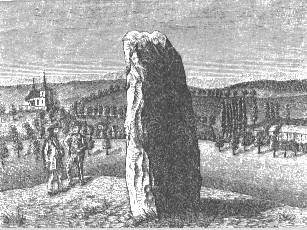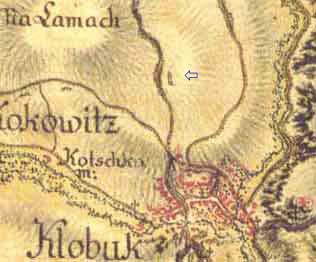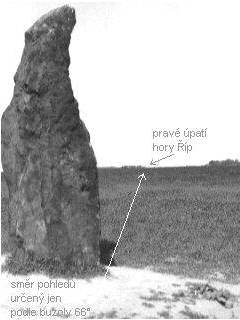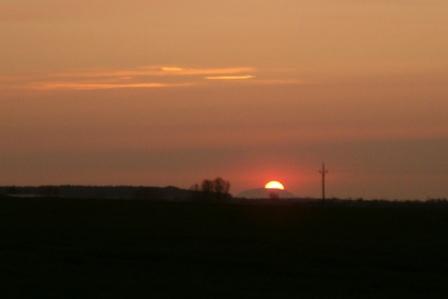K l o b u k y i n B o h e m i a
50°18´06´´N; 13°59´08´´E; 303 m ASL
Clobuch; Clobuc - in Czech language "klobouk" (a hat); prehistoric findings dating back to neolithic period; volute ceramics 5 thousand years old, "unethic" and lathen ceramics have been found within the area of Klobuky (Hats) village, along with graves uncovered complete with tool outfit from Celtic period, bronze bracelets and arms. Klobuky are reminded in year 1226 as the article of "Doksansky" monastery. Alderman (thane) seat (castle, stronghold) of some of the aldermen that have the pleading (petition, submission) right towards the churches; for instance in 1355 - Jan Clebuczkonis, Janata, Pavel Bohunek .... in year 1420 it belonged to ®irotín Castle, owned by Hasinshtein from Lobkovice; in 16th century owned by Prague Chaptehouse at Saint Guy
Motto: They stane, but stane in silent and uncommunicative majesti. Fergusson

Life picture drawn by K. Myslivec.
When I was eight years old I spent my summer vacations in Klobuky Town near Slany City, and while running with boys across the stubble-fields in direction to Telce, all of a sudden I stood in front of perpendicularly standing boulder and was asking myself full of astonishment what type of stone is it. "That´s a pertrified servant", said one of the boys. "No, they call it petrified" shepheard, shouted another one, but none of them was able to explain to me what caused the shepheard to become petrified as a punishment. About thirty years later I went this way again being a geologist, across the same countryside and I surely did not forget to visit that old petrified guy, and found it a boulder made of ferric thick-bedded sandstone belonging to the Peruc layers, that with no doubt must have had been brought here from somewhere like Vraný or Peruc.
At the same time I learned that a similar block used to stand somewhere nearby but was overturned and used as building material somewhere, somehow. Even our "shepheard" was near the same fate since one time a strong storm had overturned it as well, but today’s conscious citizens of Klobuky erected the boulder with great glory. Be they blessed with honour and praise since they maintained for our homeland a monument of a tremendously high price. Many stories and tales have spread around about this shepheard; one volume of Neubert calendar released in Slany Town brings the news about it, telling that the shepheard asked Jesus Christ and Saint Peter when they walked overhere once upon a time, to stay alive for ever and hereupon altered into stone he has been, and inside the boulder he continues to live, and so on. Also a small booklet is reported to have been released on this topic, but I could not find it.
However, the proper significance and importance of this ancient monument reminding us of the past ages have not so far been investigated and clarified accordingly, and therefore I have decided to tell about the subject in more detail. There iPeter wheey are not all of the same age and that many can be assumed very old, but that their series is able to be tracked up to the present time, where some of the nations in India still continue to put together and construct the tombstones made of huge boulders. Some have been found to date back to 4th century A.D., others to 9th century A.D. Surely some come from prehistoric period since also the Bible (Book of Moses 20, verse 19, chap. 31, verse 51, 52) narrates that Jacob built stone columns and Moses let 12 columns to be built on Sinai Mountain. Also with Romans and old Germans & Englishmen there are references to the stones where they used to meet or which served as a kind of reminder.
I think in this way I have made enough to point to the importance of similar stone columns, and that everybody will gain a credit for himself/herself when he/she contributes to finding these in his/her own country.
(Dr.Ant.Frič;Vesmír,r.VI.,č.8,1877)


In our contry the menhires belong to a rare phenomenon. Already Mr. Vocel knew about one and depicted it in his "Primeval Ages". The message deals about a boulder at the foot of Hradiste (Fortification) near Strakonice. The more famous one became the Klobuky sandstone menhir in Slany region, presented by folk either as petrified shepheard or as a Petrified Man. Some time ago yet another boulder of similar form had used to stand there as well, but was overturned to be utilized for construction purposes. The current menhir has been given a greater respect by the surrounding citizens and they treat it as the ancient monument.
When it toppled during a storm in year 1852 people erected this Klobuky Menhir with great glory, crowned it, and now keep this boulder in deference for next generation to come. Klobuky menhir stands in solitude and is 4 meters high. Only 3,5 m protrude above the ground.
Professor Frič who had devoted his article to the Klobuky Menhir in his Vesmir [Universe] magazine, year 1877, considers the rock to be of ferric thick-bedded sandstone of Peruc layers. Looking at the witnesses of ancient generations and unknown nations, in our thoughts we become absorbed in Biblical words and ask ourselves whether the menhirs had used to indicate the graves and border lines, or were not they the monuments similar to those we read about in Moses Book I:
Jacob lifted a memorial sign at that spot where he spoke, the stone column (Chap. 35, v.14). And in Book II : Moses having written down all the Lord´s words, erected the altar along with twelve columns in accord with the number of twelve generations of Israel (Chap. 24, v.4).
(Josef Kořenský; Topič Literary and Artistic Volume 915-1916)

Near The Stoneman
From the legend of our folk recorded by Ladislav Benýąek;
Malý čtenář [Little Reader] 1891
Whoever is walking along the road that leads from Klobuky to Peruc will see on his/her right side in the fields between Klobuky village and Telc village a boulder of strange and very striking appearance. It stands just at the border dividing the district of Slany from the Louny one. Also when travelling in train on Prague-Duchcov railroad this strange stone is able to be seen. It is very thin, upright and about three and a half to four meter high. The stone itself is red, coarse-grained sandstone, called by folk a "hardpan". When we watch this rather strange form made of sandstone from afar, it looks to us as if a man of outstanding size, in dark cloth, is standing still in the fields. At dusk, when looking from the west, again it seems to us as we observe a figure of a person with hands crossed over the breast, a cloth over his head and arms loosely hanging down. No surprise our folk´s fantasy managed to fabricate very early a whole series of imaginations and myths on this strange phenomenon, and this ever before they nicknamed the boulder with "Stoneman".


A pilgrim that wanders here for the first time and is overwhelmed by the unusual appearance, is stopped by an old woman grazing the geese and she spins out a conversation with him: "We call him a "Stoneman". He is said to be a servant transformed by magic into this statue. He blasphemed. Books tell all sorts of things about him - at least I hear it. If you please ask the "gentlemen" in Klobuky, they will know much more about it."
You then come to the nearest colony, meet a postal attendant. He walks to a mail train at the railway station. He still has time and is in no hurry. You enter into conversation. "What do you know about the Stoneman?" you ask. The eye of the man questioned clears up, he is evidently happy we have taken note of his surrounding´s curiosity. "A story goes about him," he explains by himself, "that each year he moves a short step closer to the Klobuky chapel. When he comes there on the top, then it will be - the judgement day (crack of doom)." The postal attendant, when having had told us what he knew about the Stoneman, smiles.
Another more learned narrator instructs us that the local formation is not of sandstone origin, and consequently the stone must have had been transported over here. "There are assumptions", he adds, "these are the remnants of a memorial of some of the commanders of the Thirty Years War." Still another narrator confirms this is a historical monument after a commander, general; however, he fires his reports about the Mr. General in such a sense that he explains the same general had thrown away his "hat" in the direction of the little lowlands alongside a creek, and that is how the name Klobuky (meaning "hats" in English) originated.
Here, all the people have a great regard for the Stoneman. The respect is however not new, it is not of present-day, but has passed ever before from fathers to their sons. The following story can prove it: In year 1852 there was a huge storm in the region during which the whirlwind had played an ugly game with the Stoneman that in no was in accord with his dignity. It literally uprooted him and knocked him down. Klobuky inhabitants were therefore very sorrow at that. The common council had a session and agreed on reerecting the Stoneman in order to maintain the old monument.

The work management was assigned to one of the members of the faithful miller´s guild. Then is was not an easy job, however. The drudgery took a couple of hours before they managed to erect his head back. Following that, the musicians and bridesmainds came. A lot of joy went on since the Stoneman was standing again on guard in the fields.
The old grandma grazing the geese had been right when telling there are textbooks written about this petrified servant. At least there is the fact the Stoneman was erected again with great glory in year 1852 as known from the memorial textbook of parish authorities in Klobuky. The old grandma also remembered that coins, in circulation at that time, had been embedded in the ground underneath the Stoneman for commemoration.
To a discerning observer a strange appearance of the Stoneman will after all remain a puzzle not solved yet. The servant petrified over here, as presented by the folk, was barely a giant three and a half to four meters tall, as the Stone can be seen. With its height it equals to the double the height of a full-grown man. Are these maybe the remnants of Thirty Years War ? Even the likelihood of this seems unlikely, at least as far as its origin is concerned. However over 250 years have passed since the Thirty Years War. Nonetheless, even this could be concerned as likely, that the Stone has maintained at least its rough resemblance of a memorial despite the fact its shape is in all directions absolutely irregular. Could it be that even over this long period of time a certain regular form might be kept? We can judge so since the sandstone is hard and therefore not easily weathered.
Most probably one of the following two remains true about the Stoneman: it is either a kind of nature´s capricious game, or it had been transported over here under some unknown circumstances and in unknown time. That is all that we can write in its memory. When the old grandma, that told us of the "servant", will learn that something more has been written about him in the books, hopefully she will be happy. It may be that some of the pupils from the neighboring schools will read to her what has been written in the children´s magazine called "Little Reader" ("Malý čtenář" in Czech version).

Termed drawing on map I. military surveying 1764 - 68,
on map 1819 - 58 in conjunction with notice
Baim fernsteinerten Hirten,
(Near stony herdsman);
on cadastral map out of year 1841 them to a acre No. c. 352 termed mark for solitary stone and notice Near The Stoneman ,
to another maps is place marked local title To The Stone,
Is the only menhir near whose was effected special archaeological survey.

Rusty brown ferrous sandstone with occurrence whitish quartz nugget.
Is high 3,4m above land, his longitude is 4,2m. Materiality estimates on five tons.
Czech geolog J. N. Woldrich asserted, that upset stone is the rest very compact and weathering more resistent nuclei of Permian sandstones in place naturally sediment,
However, arduos J. L. Píč arranged for digging near this stone back in 1898.
Despite no argeological evidence to determine the age of the stone was found, it showed the stone has been embedded in a sandy layer above the bedrock in such a way it must have had been erected artificially.
The regional historian, R. Koller, was of such an opinion the stone originates most likely from the Boyian Period. As the legend goes, the stone had been surrounded by six to twelve smaller-size stones, and it was used to be called the "Shepherd With" His Flock. This assumption has been confirmed in the message of a sugar mill accountant from year 1901, that states two hundred to three hundred meters north of the standing stone two other stones were ploughed up, and about twenty eight steps away from the standing stone in the direction of Telce another large-size stone was ploughed up.

This year we managed to verify the presumption of possible calendar function of this location. As per preliminary calculations the solar disc should have actually come forward precisely overhead the Rip summit already on April 29, 2000, because of intercalary year.
Sun declination at the rise was just 14,5° (+14°32´11´´)
the initial ray turned up behind Saint George Rotunda (5:45:47; azimuth - 66°19´), which at that moment was clearly recognizable via binoculars. A huge red solac disc with its diameter managed to overlay little by little the entire Říp Mountain, thus one mountain had been formed overhead another one.
Whether the Celts themselves were constructors, or they used devices of much older generations of the original population, will no more affect the fact the stone colossus near Klobuky was intentionally, and with high accuracy, located within the country so to be able to introduce with great beauty and graciousness the hot season of the year called Beltine.

This phenomenon recurred on August 13 at 5.50 a.m. It started late summer time - accordant with the Celtic feast callled Lugnasad.
Near stone want quantity "pseudocelts" at Midsummer for hailing return Sun. Some days about solstice is azimuth rise Sun almost invariable and doesn't know where who determine day solstice without calendar only look at horizon.
this way behind centuries switched, owing to tilting global axis. It free about Beltin and Lugnasad. There's daily change azimuth rise Sun very expressive. Weighty is declination Sun +14,5°. . One and only experience.

Jan Diviš mailed beautiful photo Beltine 2008.


